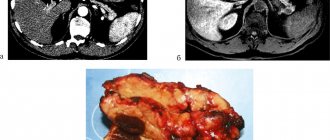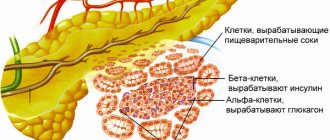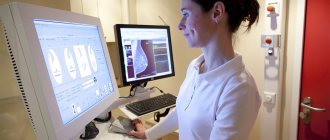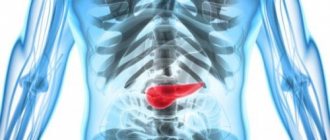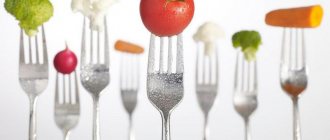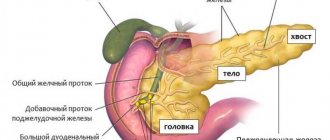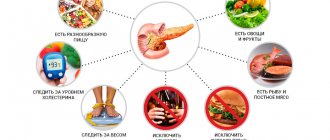Pancreatitis is a disease of the pancreas associated with the development of an inflammatory process in the organ. With this disease, there is a disruption in the flow of enzymes involved in digestion from the pancreas to the duodenum. Digestive enzymes remain in the gland itself and destroy it. The main cause of this disease is improper and unbalanced nutrition. That is why the treatment of pancreatitis is based on a properly selected diet.
General rules. Duration of the diet.
Maintaining proper nutrition is the key to a quick recovery. With this diet, you must adhere to certain rules to eliminate the possibility of complications.
General diet rules:
- Overeating should be avoided
- Meals should be fractional, at least 5-6 times a day
- Food should be warm. It is necessary to completely exclude hot and cold foods.
- Eliminate raw vegetables and fruits and fiber-rich foods from your diet.
- Food should only be prepared using recommended methods.
Symptoms of pancreatitis
Main symptoms of pancreatitis :
- Feeling of fullness in the stomach after eating.
- Pain in the navel area.
- Constant heartburn, bloating and flatulence.
- Nausea.
- Bad breath.
- Belching.
- Swelling of the face (read a useful article on how to quickly get rid of swelling on the face).
- Fat stool.
- Dry skin.
- Redness of the skin.
In addition, a large number of toxins accumulate in the body, which can poison the body.
Nutrition for pancreatitis during exacerbation:
In case of exacerbation of pancreatitis, it is necessary to avoid eating any food for several days. During fasting, it is recommended to drink purified still water. The daily volume of water should be no more than 1.5-1.7 liters. After the pain and symptoms subside, you can add low-calorie food in small quantities to the diet (liquid cereals, vegetable soups, steamed fish or chicken cutlets).
If you do not follow a diet during acute pancreatitis, the disease can quickly become chronic.
Notice!
During the acute period, sanatorium-resort treatment is contraindicated: it is better to go to a hospital.
If you have a chronic
form, then you should regularly
carry out preventive treatment
.
Pancreas
If a person is healthy and happy, there is no reason to remember that a very important organ functions in his body - the pancreas . It is located behind the stomach, closely adjacent to the duodenum, between them and the spine, transversely at the level of the bodies of the I-II lumbar vertebrae. The pancreas of an adult has a length of 14-22 cm, a width of 3-9 cm, a thickness of 2-3 cm, with a mass of about 70-80 g. Why is this gland so hidden in the body?!
Already in the Talmud there is a description of the pancreas , where it is called the “finger of God.” Vesalius in 1543 writes about the pancreas: “in the center of the mesentery, there is a large glandular formation that reliably supports the very first and significant branches of the vessels.”
The pancreas is an important participant in the digestive process; it secretes the main enzymes for the digestion of fats, proteins and carbohydrates: pancreatic lipase, amylase, trypsin and chymotrypsin. The main pancreatic secretion - duct cells - contains bicarbonate ions, which are involved in neutralizing acidic gastric contents. The main excretory duct, which opens into the duodenum, receives pancreatic secretions that accumulate in the interlobular ducts. Enzymes are released in an inactive form, this prevents enzyme damage to the pancreas, which can be observed with pancreatitis. In response to the secretion of pancreatic juice, the cells of the stomach and duodenum produce active substances of a hormonal nature - gastrin, cholecystokinin and secretin, which ensures hormonal regulation of the exocrine function of the pancreas.
Islet cells - the islets of Langerhans, located between the lobules, function like endocrine glands, secreting glucagon and insulin directly into the bloodstream - hormones that regulate carbohydrate metabolism. Glucagon increases and insulin decreases blood glucose levels.
Reasons for the development of pancreatitis: frequent consumption of spicy, fried, fatty foods, overeating, alcohol abuse, neuropsychic overexcitation, previous viral infections and intoxication.
The most important symptom of pancreatitis is burning pain in the upper abdomen, in the left hypochondrium, sometimes radiating to the heart area, to the spine, which can last from several hours to several days.
Attacks are characterized by severe pain, loss of appetite, weakness, belching, flatulence, and rumbling in the stomach . Nausea and vomiting are often associated; there may be a drop in temperature and tremors in the body. Diarrhea persists for a long time , even with proper nutrition. Mushy stools containing undigested food particles may have a foamy consistency with an unpleasant odor. The patient may lose weight very sharply. This type of pancreatitis in some cases leads to the development of diabetes mellitus.
Acute pancreatitis most often treated , because... with severe pain, loss of consciousness or shock may develop. Chronic pancreatitis requires long-term complex treatment and medical supervision.
List of permitted products:
| Cereals (buckwheat, oatmeal, rice, semolina) | The cereal must be boiled in water, followed by the addition of milk and a small amount of butter. |
| vegetables | Vegetables can be consumed as first courses (vegetable soups, puree soup) or in the form of chopped boiled pieces. Allowed fruits include potatoes, carrots, green peas, zucchini, pumpkin, beets and cauliflower. |
| fruits | Raw fruits should not be eaten. You can eat fruit jams, marshmallows, baked apples, compotes, and jelly. |
| meat | You can eat lean meats: beef, veal, rabbit and chicken. The meat is steamed and prepared in the form of soufflés or minced meat cutlets. |
| fish | Steamed white river fish is allowed in the food. |
| egg | Allows you to prepare a steam omelet from 1 chicken egg or 3 quail eggs. |
| Dairy | Dairy products should have minimal fat content |
| bread | You can eat a small amount of wheat bread 2-3 days old |
Factors of occurrence and symptoms of pancreatitis
The course of pancreatitis is characterized by constant relapses, which occur due to the release of insufficient amounts of hormones and enzymes. The point is not even in constant relapses, but in the fact that with each subsequent one the condition worsens. The tissues are gradually destroyed, which subsequently threatens serious health problems.
It is very important to remember that inflammation of the pancreas can indicate the independence of the disease, or be a manifestation of other pathologies (liver cirrhosis, alcohol intoxication or atherosclerosis).
List of fully or partially restricted products:
| Dates, grapes, bananas | Causes bloating |
| Mushrooms, legumes, white cabbage | Contains coarse fiber |
| Smoked, salted, fast food, products containing preservatives and dyes | Irritate the mucous membrane of the digestive tract |
| By-products (liver, tongue, heart, kidneys, etc.) | Contains a lot of cholesterol |
| Any fried or fatty foods | Lead to exacerbation of the disease |
| High fat dairy products | High risk of exacerbation or complication of the disease |
Table 5 diet
Below is a basic list of do's and don'ts for diet number 5 . Your doctor will give you more detailed information, focusing on the individual characteristics of your body and diagnosis:
- Soups. Light vegetable and cereal meatless first courses are allowed. Decoctions of meat and fish and cold first courses are prohibited.
- Root vegetables and other vegetables. It is allowed to consume some of the pumpkin, nightshade and cabbage families, and kelp. Vegetables that increase stomach acidity and irritate its internal walls, canned vegetables, and regular cabbage are prohibited.
- Meat. It is allowed to eat low-calorie meat (the skin is removed), low-fat beef, as well as homemade semi-finished meat products. A categorical no - all fatty sausages, fatty meats, offal, etc.
- Fish and seafood products. You can eat fillets of lean fish and crustaceans. Not allowed: fatty fish fillets, canned fish, Japanese dishes, caviar.
- Flour products, bakery. You can eat all types of bread, toast, and unsoaked biscuits. You can’t eat butter and puff pastries, store-bought crackers, home-fried pastries.
- Cereals. Cereals boiled until very soft, the addition of dried fruits and lean meat to pilaf, flaxseeds, and muesli are allowed. All types of legumes, barley, corn and barley cereals (in small quantities) are prohibited.
- Milk and its derivatives: natural milk and low-fat products of its oxidation, cottage cheese, hard cheese without seasonings are allowed. High-fat milk and salted cheeses are prohibited.
- Eggs and their derivatives - only foods made from proteins are allowed. Dishes made from whole eggs are prohibited.
- Fruits and berries. Ripe apples, some types of dried fruits, and fruit and berry compotes are acceptable. All types of nuts, seeds, citrus fruits, and raw fruits and berries are unacceptable.
- Sweets. You can eat low-calorie and non-acidic sweets, honey. Not allowed - some types of oriental sweets, chocolate-cream products, hematogen, chocolate.
- Non-alcoholic and alcoholic products. It is allowed to drink rosehip and chamomile infusions, weak black teas, and berry and fruit drinks. Prohibited: any alcoholic beverages, soda, concentrated juices, coffee, etc.
Based on the above, you can create an interesting, healthy and satisfying menu. Try to make a list of dishes in advance - it will be easier. You can immediately buy what you need and create a recipe. And it will take less time and effort to cook.
Diet for different forms of inflammation
After an attack of acute pancreatitis, namely for 3 days, complete fasting is necessary. Its goal: to stop the production of juice that digests the pancreas itself. During this time, the signs of the disease subside. To neutralize the acidic environment of the stomach, it is recommended to drink alkaline mineral water. You can only eat dishes in the form of puree or soufflé.
Chronic pancreatitis is characterized by rapid loss of proteins. To replenish the body’s protein reserves, they must be constantly included in the diet; a third should be of plant origin. Dairy products can be taken both in the morning and in the afternoon. The source of energy remains carbohydrates contained in potatoes, crackers, pasta and cereals. These recommendations are also observed when organizing holiday feasts.
Fruits in remission
During the period of remission of pancreatitis, it is allowed to introduce more fresh fruits and berries into the menu. It is recommended to consult a gastroenterologist first. When consuming certain fruits, it is important to exclude possible allergic reactions (for example, to citrus fruits, red or orange fruits, specific types of berries).
Inflammatory processes in the pancreas can provoke an exacerbation of food allergies. The intensity of negative symptoms with a combination of such pathologies will be higher.
List of healthy fruits and berries during remission
Fruits that fall into the category of permitted foods during remission of pancreatitis not only do not cause harm to the digestive tract, but also provide benefits. The main condition for their introduction into the diet is gradualness and compliance with proportions. If there are too many of these fresh fruits in the diet, there will be a risk of abnormalities in the digestive processes (bloating, heartburn, flatulence).
Useful fruits:
It is forbidden to eat any food that increases the production of enzymes designed to break down food. persimmon;- watermelon;
- currant;
- pears;
- apricots;
- grape;
- peaches;
- blueberry;
- cherry.
Basic rules for selection and use
- When choosing, pay attention to the appearance of the vegetables. Choose ripe ones, not overripe ones. Strong to the touch, but not wooden. The skin must be strong, without visible defects and wormholes. There should be no traces of rot or mold.
- Canned or salted products are prohibited.
- Before eating vegetables, prepare your stomach by eating a small dose of acceptable food.
- Don't be afraid to add starchy vegetables to your menu.
- Do not fry vegetables.
- Be sure to boil the product before use.
- Vegetable broths should not be used.
- Remove seeds from vegetables; they are poorly absorbed by the body.
- Prepare small portions, gradually accustoming your body.
- It will be useful to use freshly squeezed potato juice. For cooking, ripe potatoes are selected, without damage. It is allowed to mix potato and carrot juices. The effectiveness of the drink for restoring the body will be much higher.
- At the remission stage, it is already permissible to prepare salads from fresh vegetables; cucumbers are useful. Add olive oil. You will get dishes rich in vitamins.
Indispensability and potential danger of fruits
On diet days, a sick person's diet should remain balanced. The patient receives the necessary substances: proteins, carbohydrates, fats, microelements and vitamins. Fruits are full of vitamins and various microelements. Many contain natural enzymes; due to the composition of the chemical components, part of the load is removed from the pancreas when processing food.
Fruits contain coarse fiber, which complicates digestion during periods of exacerbation of the disease. The large amount of sugar in some fruits is dangerous. Fruit acids also have an irritating effect on the gastrointestinal tract.
When compiling a dietary menu, the current phase of the disease, the presence of concomitant diseases, and individual intolerance are taken into account. Many fruits should not be used when pancreatitis presents with pain and other symptoms. During remission, ripe fruits are beneficial and help prevent the disease. The division of fruits into permitted and prohibited is conditional; different doctors have different opinions about any fruit.
It is recommended to add fruits to your diet one at a time, monitoring the body’s reaction. If a certain type causes unpleasant consequences, it is better to refuse. It is very useful to use dried fruits for diseases of the gastrointestinal tract, for pancreatitis - dried berries and fruits that retain vitamins and microelements needed by patients in a concentrated form. During exacerbations, it is allowed to drink dried fruit compote. During calm periods, dried fruits are eaten directly, washed well (store-bought) and soaked in hot water. You should not use dried fruits from sour berries, for example, cranberries.
Sample menu for the week
If you don’t understand how to create a menu and what it consists of, see the approximate list for the day.
Day 1
- First time: milk oatmeal with the addition of pureed fruit, tea.
- Repeated breakfast: tea, grated low-fat cottage cheese.
- Second meal: beetroot soup, buckwheat porridge with meatballs, bread, sour cream (10 grams).
- Third method: baked zucchini pancakes, sour cream (10%).
Day 2
- First time: manna, tea with milk (a little).
- Repeated breakfast: toasted wheat bread, jam, slightly acidic jam, weak tea.
- Second meal: lean cabbage soup, a piece of bread.
- Third meal: berry drink, buckwheat cereal. How to prepare it: bring 200 grams of buckwheat until boiled. Cottage cheese (200 grams) wipe, add 1 tbsp. l. sugar, beat in an egg, add 100 ml of milk. Next, combine all the ingredients, add to the buckwheat, and bake in foil in the oven.
Day 3
- First time: steamed carrot pancakes, tea.
- Repeated breakfast: regular cookies, dried fruit compote.
- Second meal: pearl barley soup, low-fat sour cream (a little), bread.
- Third method: boiled cauliflower, steamed chicken dumplings.
Day 4
- First time: semolina casserole, low-strength black tea. How to prepare the casserole: make thick semolina, leave to cool (dosage - two hundred grams). Next, add sugar, 1.5 eggs and a little dried grapes (optional, finely chopped dried plums). Whisk the mixture until fluffy, pour onto a pre-greased baking sheet, and bake until golden brown.
- Repeated breakfast: unsoaked sponge cake, fruit compote.
- Second meal: rice and vegetable soup, separately cooked chicken.
- Third method: chamomile or rosehip infusion, boiled raisin couscous.
Day 5
- First time: milk oatmeal, tea.
- Repeated breakfast: cucumber-carrot salad with the addition of lettuce leaves.
- Second meal: lean borscht, a slice of bread, a small amount of sour cream.
- Third meal: stewed vegetables, some lean beef.
Day 6
- First time: baked pears, honey, tea.
- Repeated breakfast: wheat bread, soft curd mass.
- Second method: milk noodles.
- Third meal: mashed potatoes, meatballs with sour cream sauce, rosehip drink.
Day 7
- First time: protein scramble with the addition of boiled green beans, tea.
- Repeated breakfast: carrot salad with dried apricots.
- Second meal: oatmeal soup, with potatoes and carrots, bread.
- Third meal: meat soufflé, rye toast, chamomile infusion. How to cook: take beef (200 grams), boil, run through a blender a couple of times, add the yolk. Next, add 100 ml of milk and mix. Whisk 2 whites until foamy and add to meat. Steam cooking.
If you still feel hungry, you can snack and have an afternoon snack.
The presented menu is not the main one; you can adjust it yourself. The main thing is to follow the rules: food is only warm; portions are small; ingredients are acceptable.
Cooking methods
At the stage of exacerbation of pancreatitis, it is important to limit the vegetable selection. During the period of remission, you are allowed to play with a variety of ways to prepare permitted vegetables. Boiled, baked, stewed vegetables for pancreatitis will help restore the body.
Boiling Features
It is important to properly boil vegetables, preserving the maximum amount of vitamins. Root vegetables or fruits are washed and boiled until tender in a small amount of water. Place vegetables in boiling water. It is better to cut into large pieces or leave whole to preserve the nutrients. Frozen vegetables are not defrosted; they are placed cold in boiling water.
Extinguishing
In the classic version, stewing is something between boiling and frying. Stew means cooking with the addition of liquid and fat at the same time. The procedure takes place under a closed lid. Vegetables need to be washed and peeled, cut into larger cubes, placed in a bowl, and sparingly salted. Pour a little fat into the bottom of the selected dish. Add liquids - water, milk. When the water boils, reduce the heat and simmer until done. You can cook in a frying pan, in the oven, or use a slow cooker.
Baking
When baked, vegetables acquire a unique taste and aroma; it is important not to overcook them in the oven, otherwise they will turn out dry and tasteless. The secrets of baking are known. Root vegetables are pre-wiped with a paper towel. Then place in the oven on a rack on the middle level.
When baking onions, it is better to cook them whole. Eggplants are cut into circles. The vegetable is not salted before cooking in the oven, preventing the release of juice and the appearance of soup or puree. A delicious dish - stuffed vegetables. Baking mashed is possible.
Having familiarized ourselves a little with the rules of nutrition for pancreatitis, we can conclude: avoiding inconvenient restrictions and dependence on the disease, you need to lead a healthy lifestyle. Sometimes it’s not easy to accomplish your plans because there’s not enough time. But it is better to eat vegetables to improve the body than to treat pancreatitis.

